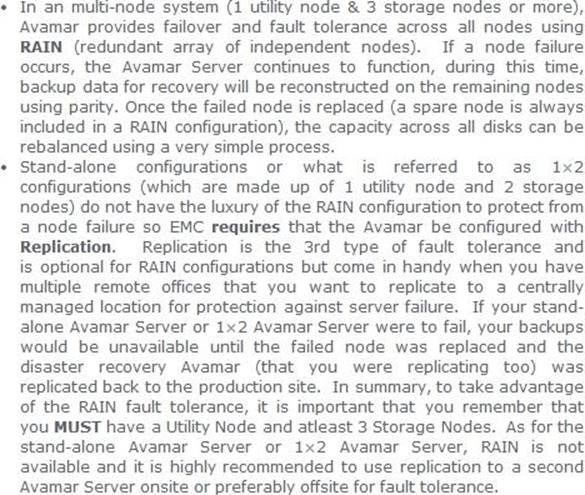- All Exams Instant Download
What is the minimum amount of nodes, of all types, that is required to support this functionality?
An EMC Avamar customer, without premium support, has a requirement to be able to recover from a failed storage node.
What is the minimum amount of nodes, of all types, that is required to support this functionality?
A . 1
B . 2
C . 3
D . 5
Answer: D
Explanation:
Single Node.
Also known as the Non-RAIN (Redundant Array of Independent Nodes) configuration. This is the entry level configuration in which the single node acts as the utility node and the data storage node. When using this configuration 2 single nodes are needed. 1 is the main backup node, and the 2nd is used for replication purposes for fault tolerance. Used in small to medium sized environments.
Muti-Node Non RAIN.
This is basically is a 3 node setup consisting of 1 Utility Node and 2 Data Storage Nodes. It allows for double the storage capacity of a Single Node device.
This configuration also needs a duplicate setup for replication, so a total of 6 Nodes would be needed for fault tolerance. Used in medium sized environments.
Multi-Node RAIN.
The Standard RAIN configuration has 1 Utility Node, 4 Data Storage Nodes and 1 Spare Node. This
configuration can be expanded for a total of 16 Data Storage Nodes max. All of the nodes work together to balance the storage equally across all of the other Data Storage Nodes. This architecture is easily scaled by adding as many Storage nodes as necessary. Typically used in large environments, this configuration can be initially setup with 3 Storage nodes instead of the standard 4 Storage nodes. It is recommended to setup a duplicate Multi-Node RAIN for replication, typically at a DR site. Although it is recommended, it is not a necessity like the Non-RAIN configurations, because there is a spare node that can be configured at any point for fault tolerance.

Latest E20-598 Dumps Valid Version with 237 Q&As
Latest And Valid Q&A | Instant Download | Once Fail, Full Refund
Subscribe
Login
0 Comments
Inline Feedbacks
View all comments

